The latest on Canadian wildfires
Yellowknife’s 20,000 residents continue to evacuate as wildfires approach the city. Meanwhile, a state of emergency was declared early Friday in Kelowna, B.C., after wildfires jumped Okanagan Lake.
- Twenty-six evacuation flights were scheduled out of Yellowknife for Friday. Ottawa says it is contracting private planes to supplement military efforts.
- Kelowna, a city with a population of about 150,000, has declared a state of emergency in the face of the McDougall Creek wildfire.
- Thousands of properties near West Kelowna are under evacuation orders. The local fire chief said Friday an unspecified number of homes are burning and conditions suggest another difficult night ahead.
- The Canadian government has demanded that Meta lift a ban on domestic news from its platforms to allow people to share wildfire information.
Emergency resources
- N.W.T. residents who need to evacuate can register with the territory. Those seeking more information about evacuations and wildfire updates can check online or call 1-844-259-1793. Smoke or fire can be reported to 1-877-698-3473.
- The Central Okanagan Emergency Operation Centre is asking evacuees to register through B.C.’s provincial portal. Residents can check an interactive map to check if their home is under evacuation order.
- West Kelowna and Central Okanagan residents can visit the B.C. government website for more information.
Find updates from our reporters below.
11:47 p.m. ET
Dozens of hospital patients remain in Yellowknife
Despite a significant effort to discharge and relocate hospital patients over the past few days, at least 38 patients remain at The Stanton Territorial Hospital in Yellowknife.
According to Alexander Keefe, a spokesman for Northwest Territories Health and Social Services Authority, these are “more complex” inpatients and require medical care and support. “The goal is to have the hospital patient evacuation completed in the next 24 hours,” Mr. Keefe said in an e-mail Friday afternoon.
Chief Warrant Officer Richard Francoeur, during the Friday evening press conference, said a C-17 was on the tarmac in Yellowknife and crews were working with staff from the hospital to evacuate the “last patients” from the city.
Asked why logistics were not organized before the official evacuation order, Kimberly Riles, the Northwest Territories Health and Social Services Authority’s chief executive, said the situation developed very quickly.
“We had actually undertaken the initiation of hospital evacuation plan that was going to be phased over a number of days. But with the pivot to a full evacuation order, we went to a single-phased request for a mass air medical evacuation,” she said.
Ms. Riles said there were 39 patients being evacuated, one more than the figure her department provided earlier in the day. Most of the remaining patients are expected to end up in facilities in British Columbia.
The hospital’s emergency department will continue to operate in order to serve the essential workers still in the city.
– Globe staff
10:26 p.m. ET
2,600 people remain in Yellowknife following evacuation deadline
Officials in the Northwest Territories say 19,000 people have followed an evacuation order and left Yellowknife.
They say about 2,600 people remain in the capital, 1,000 of them essential workers.
Yellowknife Mayor Rebecca Alty is urging any non-essential workers still in the city Friday night to leave by highway or air.
She says while smoke lifted for a bit today, it has come back and the blaze at the edge of the city remains a significant threat.
Shane Thompson, the territory’s environment minister, says people staying behind are endangering themselves and others.
He says the highways and airport could be compromised if the wildfire moves quickly, so people need to “get out now.”
Yellowknife’s wildfire information officer Mike Westwick says the weather has been helpful in fighting the blaze.
Cooler temperatures and moisture in the air, along with firefighting efforts, have helped keep the fire about 15 kilometres from the northwest edge of the city.
Prime Minister Justin Trudeau met with wildfire evacuees from NWT at an evacuation centre in Edmonton.
He said the evacuation has been done in a thoughtful way and urged residents to listen to evacuation orders.
– The Canadian Press
9:36 p.m. ET
B.C. declares province-wide state of emergency
The British Columbia government declared a state of emergency on Friday afternoon as a result of escalating wildfires across the province, a move that Emergency Management Minister Bowinn Ma said would give her government extraordinary powers.
This includes the ability to order people off the highways if travellers do not voluntarily heed the government’s demand not to travel for anything other than emergency reasons. The state of emergency also allows the government to compel the provision of accommodation.
There are now about 15,000 people on evacuation order, a rapidly increasing number, Ms. Ma said. A further 20,000 are on evacuation alert, meaning they need to be ready to flee should an evacuation order be called.
“The speed with which we are going from a potential threat to an imminent threat is incredibly concerning,” she said.
It’s the height of the tourism season in the Okanagan, but Ms. Ma urged people to cancel plans to travel to the area as hotel rooms are needed for first responders, health care workers and evacuees. She also said the highways need to remain clear for emergency response vehicles.
“There are certainly difficult days ahead,” Premier David Eby said at the news conference.
7:25 p.m. ET
Hay River says rainfall, shifting winds helping curb fire threat
The Northwest Territories town of Hay River, a community across Great Slave Lake from Yellowknife, said Thursday was a “positive day” for fire activity because of rainfall and shifting winds that restricted the growth of the wildfire that had sparked an evacuation order on Sunday.
All medical patients and long-term care residents have been evacuated from Hay River, according to an update on social media Friday, but around 200 people have yet to leave. The town’s population is roughly 3,500, and the only two highways out of the community have been compromised by blazes.
“There are roadblocks and gridlocks in place in some areas, and Hay River Fire is working on suppressing fires and hotspots back from the highway today,” the territorial fire service said in an update Friday.
Overcast skies and cooler temperatures were expected to give crews critical time on Friday to make progress on the wildfire. The service also said that 100 Canadian Armed Forces members would be arriving by plane, in addition to 100 by car.
Enterprise, a hamlet just 40 kilometres south, was destroyed by the fire threatening Hay River. Only a handful of homes remain standing in that 100-person community.
7:03 p.m. ET
Yellowknife evacuees land in Calgary, hoping all is well when they’re allowed to return
Todd Hayward pulled his mother-in-law, Shirley Bohnet, into his arms for a big hug, a smile on his face, in front of the evacuee reception centre at the Calgary airport on Thursday evening. Ms. Bohnet had just landed from Yellowknife, fleeing with her husband from the fire-threatened city.
“It’s been a while since they’ve been down here or I’ve been up to Yellowknife so it’s good to see them,” said Mr. Hayward, who drove three hours from Red Deer to pick them up. “It’s more of a relief for my wife. She’s been glued to the news for the last couple days.”
Ms. Bohnet, 75, said it had been a stressful week. Her husband wanted to shelter in place at their apartment in downtown Yellowknife, hopeful the fire nearing the city’s boundary would be stifled, but they decided it was too risky. They waited hours in line for a bus to the airport on Thursday, but said their journey to Alberta was otherwise smooth.
All they brought were essential documents and clothes, leaving sentimental items back home. Ms. Bohnet is optimistic that all will be well when they return, despite not knowing when that might be.
“Obviously it would be nice to be home. And, I don’t know, I keep thinking, should we have left? Or should we have stayed and hunkered down?” she said. “But I thought we better leave just in case.”
6:40 p.m. ET
West Kelowna residents flee by car as fire nears
Nikki Sihlis and her husband, Royce, stood in a parking lot outside their Shannon Woods neighbourhood in West Kelowna on Friday, watching the fire that had forced them out of their homes two hours earlier. Charred, fist-sized embers landed all around them. The wind had been blowing southwest and was now shifting, pushing the fire directly toward their home of 11 years.
They wore forced smiles for the benefit of their children, 5 and 7, who were popping in and out of the windows of their silver SUV, giggling wildly. But the couple’s wide, frightened eyes betrayed how they were really feeling.
“I’m so scared,” whispered Ms. Sihlis, a wedding planner, briefly turning away from her son to speak.
Before leaving home, she and Royce, a photographer, watered down their home one last time. They left the hose on the front lawn along with several large buckets filled with water, hoping firefighters would spot them, should the need arise.
Behind the Sihlis family, a long line of cars – headlights on to cut through the thick grey smoke – were leaving West Kelowna. The inbound lane was all but empty, except for trucks hauling the heavy equipment needed to try to keep the community and its people safe.
Paul Mattie fled his home in West Kelowna’s Rose Valley neighbourhood on Wednesday around 11 p.m. He slept on a park bench in the Okanagan community of Peachland on Thursday night.
Mr. Mattie, a journeyman cabinet maker, never heard an official evacuation order. When he saw the eerie red glow of flames charging down the hill toward him from two directions, he knew it was time to go.
“It’s so scary,” he said, pointing to the flames, roughly a kilometre from his home. “This fire got so big, so fast.”
Behind him, a steady stream of helicopters were dropping buckets of water near the elementary school.
“It’s been so dry these last three years, I almost knew it was coming.”
Mr. Mattie had remembered to grab his computer when he left, but forgot all of his photos. Mostly though, he was worrying about the furniture he’d built over the years in his garage: “To me, that’s priceless.”
Above him, a group of locals watched the fire approach from a lookout at Grizzli Winery. Inside, the manager, her eyes glistening with tears, sent her two remaining staff home. The winery was empty, with no reason to stay open any longer.
5:58 p.m. ET
Lake Okanagan Resort destroyed; UBCO under evacuation order
The historic Lake Okanagan Resort has been destroyed by the McDougall Creek wildfire.
West Kelowna resident Les York says he watched from a boat on the lake as the resort burned Friday morning.
York says he could hear explosions as flames engulfed the buildings, and he saw numerous other lakeside properties destroyed.
Meanwhile, the University of British Columbia Okanagan has issued a statement saying its campus in Kelowna is subject to an evacuation order.
It says anyone on campus must leave immediately, and those without access to transportation should make their way to “H Lot” parking.
B.C. officials told a briefing this afternoon that about 4,500 people are under evacuation order across the province, with another 23,500 on alert.
Emergency Management Minister Bowinn Ma says non-essential travel to Central and Southeast B.C. should be avoided to give firefighters the space they need.
– The Canadian Press
5:28 p.m. ET
Flames in Fraser Canyon reaching heights of 120 to 150 metres
Officials described hellish fire behaviour in B.C.
Cliff Chapman, director of provincial operations for the BC Wildfire Service, said a fire in the Fraser Canyon has created a large pyrocumulonimbus cloud, a weather phenomenon that can shoot flame into the atmosphere. He said in his 20 years of experience he’s seen little like it.
“There were real concerns yesterday from people in Vancouver that there was a volcanic eruption,” he said, with flames reaching heights of 120 to 150 metres in the air.
“There is very little that response tactics can do with these winds and that type of fire behaviour. And so when I say extreme, what it means is that they [fire] are moving faster than we can effectively put firefighting resources on them.”
5:05 p.m. ET
Yellowknife highways open, flights continuing past noon evacuation deadline
It’s not yet clear how many people are left in Yellowknife as the noon deadline to leave the wildfire-threatened capital of the Northwest Territories passed.
Some are still waiting to board evacuation flights to Calgary, while a few have stayed behind to feed fire crews and other emergency officials.
The deadline “doesn’t mean that the highway closes at noon,” Mayor Rebecca Alty told the CBC. “We’re just really encouraging folks to go as soon as possible. The highway will continue to be open as long as it’s safe.”
Flights will also continue after the deadline, Ms. Alty said.
Around 65 per cent of the population of 46,000 in NWT looked set to be evacuated. Prime Minister Justin Trudeau will visit a wildfire evacuation centre later on Friday, his office said.
– The Canadian Press, Reuters
4:30 p.m. ET
More B.C. areas under evacuation order
The Central Okanagan Emergency Operations Centre has placed additional properties under evacuation order in areas north of Kelowna.
It says several dozen properties along Finch Road, as well as properties along McKinley Road and Glenmore are being “tactically evacuated by emergency responders.”
The centre says all properties accessible from Quail Ridge Boulevard must also be evacuated, including the Quail Ridge Golf Club.
The centre also says a local state of emergency has been declared in the District of Lake Country, north of Kelowna.
It says an evacuation order has been issued for properties in the Nighthawk Tyndale area, including those located along Tyndall Road north of Okanagan Centre Road to Camp Road.
The order also spans properties on Okanagan Centre Road between Lakestone Drive and 10th Street.
An evacuation alert is also in effect for areas north of the boundary between the City of Kelowna and the District of Lake Country and west of Highway 97.
Meanwhile, the Regional District of Okanagan-Similkameen has expanded evacuation orders in a rural area northeast of Keremeos to cover more than 200 properties and lots.
The BC Wildfire Service says the Crater Creek wildfire spans 220 square kilometres near Cathedral Provincial Park, which is also subject to an evacuation order.
The service says 37 personnel are assigned to the fire, but it’s burning in steep and dangerous terrain, posing risks and challenges for firefighters.
It says visibility is poor, and aerial support will be available once it clears up.
The Squamish-Lillooet Regional District has expanded an evacuation order in response to the Downton Lake wildfire burning out of control northwest of Lillooet.
The district says RCMP and other authorities will be “expediting” the evacuation.
It says the order now covers all properties in the district’s electoral area “A” that are west of Terzaghi dam, located on the eastern shores of Carpenter Lake.
That includes the Gun Lake, Lajoie Lake, Slim Creek, Marshall Lake and Tyaughton Lake areas, as well as Gold Bridge, Brexton and Bralorne.
– The Canadian Press
3:54 p.m. ET
RCMP investigating suspected arson after fire on bypass road in Yellowknife
Yellowknife RCMP are investigating a suspected arson after a fire erupted overnight on a bypass road on the west side of the city, the third alleged arson since Tuesday as residents flee their homes under threat of a lightning-caused wildfire.
Mounties said an aerosol can was found on Deh Cho Boulevard after firefighters extinguished a blaze that was reported to authorities just after 4 a.m. on Friday. RCMP said in a press release that officers, with help from police dogs, were unable to locate anyone in the area and no arrests have been made.
“The area this fire occurred is somewhat remote and that means that the person responsible had to specifically travel to the location to deliberately set this fire,” said Corporal Matt Halstead, a spokesperson with the RCMP.
“This fire was set behind the fire defences and in an area where it could have spread significantly before it was detected. This is a serious criminal act and the RCMP will investigate this incident and other recent arsons, to the fullest.”
Late on Tuesday evening, the RCMP were called to two separate cases of alleged arson.
The first fire, spotted by officers on patrol just after 10 p.m., was determined to be human caused after two men dressed in black clothing were seen by a witness running from the area. The RCMP were unable to locate the individuals and the fire remains under investigation.
Shortly after, at 11:21 p.m. on Tuesday, RCMP received a call that four women were trying to start a fire in a small green space on Burwash Drive, a residential street. The suspects were arrested and have since been charged with arson, according to police, who said aerosol cans and lighters were found in the suspects’ possession and at the scene.
The following night an evacuation order was issued for all residents in Yellowknife because of a fire near the city limits. The territorial fire service said in an update Friday that the blaze is now 15 km northwest of the municipal boundary.
“It is completely beyond understanding that in the face of everything going on in the territory and the threat approaching our city, that people would actively attempt to start fires and endanger our community members,” Cpl. Halstead said in a news release on Wednesday.
“It should go without having to be said, incidents like these pose a very serious risk to our community. A significant fire behind the city’s line of defence could have devastating consequences and take valuable resources away from the ongoing wildfire fighting efforts that are under way.”
3:36 p.m. ET
Ottawa demands that Meta lift ban on news on its platforms
The Canadian government on Friday demanded that Meta lift a “reckless” ban on domestic news from its platforms to allow people to share information about wildfires in the west of the country.
Meta started blocking news on its Facebook and Instagram platforms for all users in Canada this month in response to a new Canadian law requiring Internet giants to pay for news articles.
Some people fleeing wildfires in Yellowknife have complained to the media that the ban prevented them from sharing important information about the fires.
“Meta’s reckless choice to block news … is hurting access to vital information on Facebook and Instagram,” Heritage Minister Pascale St-Onge said in a social media post.
“We are calling on them to reinstate news sharing today for the safety of Canadians facing this emergency. We need more news right now, not less.”
Ollie Williams, who runs Yellowknife’s Cabin Radio digital radio station, told the CBC that people were posting screenshots of information on Facebook since they could not share links to news feeds.
In response, a Meta spokesperson said by e-mail that the company had activated the Safety Check feature on Facebook that allows users to spread the word that they are safe in the wake of a natural disaster or crisis.
– Reuters
3:21 p.m. ET
Time lapse shows progress of wildfire threatening Kelowna, B.C.
Massive clouds of smoke closed in on Kelowna on Aug. 16 and 17. Today, airspace was closed to clear the way for water bombers.
Time-lapse video from a webcam in Kelowna, B.C. shows large smoke clouds from a wildfire approaching the city on August 17 and 18. Footage courtesy KelownaNow.
The Globe and Mail
3:12 p.m. ET
Alberta Health Services will support up to 200 home-care patients from evacuated north
Alberta Health Services, the provincial health authority, is preparing to support between 150 and 200 home-care patients from the Northwest Territories as part of the massive evacuation effort. AHS has already placed 48 continuing care patients from NWT in facilities in Alberta, according to spokesperson Kerry Williamson.
AHS is also treating four acute care patients and 19 dialysis patients from NWT at various sites in Alberta, he said. It is supporting about 30 obstetrical patients at a number of sites in Red Deer, Calgary and Edmonton.
The health authority is also providing support at reception centres in Edmonton, High Level, Fort McMurray, Valleyview, Fox Creek, Peace River and Grande Prairie. Available supports and services include addiction and mental health, home care, public health, Indigenous wellness and pharmacy support.
NWT evacuees are arriving in Alberta by air and by highway. Places like Fort Smith, Hay River, Enterprise and K’atl’odeeche First Nation were instructed to leave their homes prior to Yellowknife’s 22,000 residents being ordered out of the capital.
“AHS, along with Alberta’s government and other provinces and territories, is working closely and collaboratively with the NWT to support evacuation efforts for impacted patients and continuing care residents,” Mr. Williamson said in a statement.
3:02 p.m. ET
Live footage from Kelowna shows haze over region
KelownaNow has provided access to a live webcam from their Landmark 6 office tower in Kelowna, facing toward Kelowna West.
2:55 p.m. ET
Military pitching in to help evacuate Yellowknife, Defence Minister says
At a virtual news briefing, Defence Minister Bill Blair said the first military evacuation flight from Yellowknife took place on Thursday night on board a Hercules aircraft that carried 79 long-term-care residents to Edmonton.
Mr. Blair said the military has aircraft capable of moving patients, such as those on a stretcher or in a wheelchair, as well as medical personnel.
“The logistics of moving people from the hospital, we had to make sure that we had the right equipment, but also the right personnel so that it can be done safely,” Mr. Blair said. “The logistics of that have been worked out.”
Mr. Blair noted that the evacuation of Fort McMurray in 2016 evolved more rapidly and with a greater sense of urgency.
“The fires that are encroaching on Yellowknife, there’s still ongoing efforts to slow the encroachment and the advance of those fires into the community,” he said.
“But I think officials, quite appropriately, have been working very carefully to ensure that there was a methodical, staged and appropriately timed evacuation of people from the community.”
The Canadian Armed Forces is providing logistical support for territorial authorities and local firefighting crews, Mr. Blair said, noting that Canadian Rangers are assisting with evacuees at the Yellowknife airport.
Emergency Preparedness Minister Harjit Sajjan called the situation in Kelowna “very concerning.”
Mr. Sajjan said that the government operation centre has contacted its B.C. counterpart for an update and were told that the “best crews are actually on this fire.”
He said, however, that the winds were “very concerning” and “we didn’t know where things were going.” He said it has become more apparent that some of the fire has shifted.
“One thing I can assure you is that we have offered up full federal support,” he said, adding he encourages all residents to listen to the guidance of local authorities.
Mr. Blair also said Friday that he wants to assure residents of Yellowknife that RCMP officers will be in the community to ensure the evacuation is orderly and homes are kept safe.
2:45 p.m. ET
As evacuation efforts continue, Yellowknife braces for advancing blaze
Evacuation efforts in Yellowknife continue following a noon local time deadline to leave the city as a large wildfire threatens the community.
The fire, last mapped at just shy of 167,000 hectares, remains out of control 15 kilometres northwest of Yellowknife, the territory said in an update posted to the government website Friday morning.
The update notes “critical, challenging days ahead” are expected, with high winds predicted to push the fire toward the city.
“There is a possibility that this fire reaches the outskirts of Yellowknife by the weekend driven by these northwest and west-northwest winds,” the post reads.
There is the potential for rain, with up to three millimetres forecast in the Yellowknife area.
NWT reported 3,699 vehicles were tracked crossing the bridge out of the territory on Thursday.
2:17 p.m. ET
Calgary to receive 26 more evacuation flights from NWT
Calgary expects to receive 26 evacuation flights from the Northwest Territories on Friday, with the planes carrying about 2,300 people, according to an update from the Alberta city Friday morning.
Calgary, which has the capacity to host 5,000 evacuees, said 15 flights arrived on Thursday, with 1,269 passengers on board. Late Wednesday, NWT officials gave Yellowknife’s 22,000 residents until Friday at noon to leave the city because of wildfires and smoke.
Other areas in NWT, including Hay River and Fort Smith, evacuated ahead of Yellowknife, meaning communities in northern Alberta are at or near their capacity to host evacuees. Edmonton plans to open an evacuee reception centre Friday but the city did not indicate how many people it could accommodate.
Calgary Emergency Management Agency (CEMA) has provided 495 hotel rooms for evacuees, the city said Friday, though the number could change as people continue to arrive at the city’s two reception centres. One reception centre is in the airport for those flying in and another is at the Westin Calgary Airport hotel for those arriving by land.
“Our hearts go out to those affected by the wildfires in the Northwest Territories. We will continue supporting the Calgary Emergency Management Agency, including having our teams in their evacuee reception centre at the airport, and all other partner organizations involved in the evacuation efforts,” said Chris Miles, vice-president of operations and infrastructure at the Calgary Airport Authority.
2:06 p.m. ET
Homes burning and many structures destroyed, says West Kelowna Fire Chief
West Kelowna Fire Chief Jason Brolund said the situation was intense and dangerous overnight, something firefighters described as “a hundred years of firefighting in one night.”
He said a “significant” number of structures were lost, including houses, though he said it was too early to give a specific number. “There are homes burning out there right now and there are homes at risk.”
RCMP officers knocked on thousands of doors, ensuring people understood the evacuation order was urgent.
Still, Mr. Brolund said first responders were trapped by the flames. “Those emergency responders were trapped because they were rescuing members of the public who had chosen not to leave.”
He added that anyone on evacuation alert should be prepared to leave at a moment’s notice. “We put you on evacuation alert for a reason. This is the real deal.”
Mr. Brolund said as bad as last night was, worse may be on the way because of windy and continuing hot and dry weather conditions.
“We knew it was going to be bad and this is what we planned for and this is what we practise for. But it was exponentially worse than we expected.”
He said in one case, members of a household on evacuation alert had refused to leave. But as the flames closed in, emergency responders, including RCMP and BC Wildfire Service firefighters, had to extract them. Mr. Brolund didn’t say how many had to be evacuated.
“That was just one of what was likely many situations that took place last night,” he said. “In that case, they couldn’t make it out because the fire had burned across the block and blocked the road. . . There was only one way in and one way out,” Mr. Brolund said.
“We will risk a lot to save a lot. And there were a number of risks taken to save lives and property. But there were also risks that didn’t have to be taken.”
Mr. Brolund said emergency responders also had to rescue people who had jumped into Okanagan Lake in one neighbourhood that was threatened.
He urged homeowners on alert to clear their yards of unnecessary fuel, like straw doormats or wood piles close to structures.
Around 9 p.m. Thursday night, photographer Shawn Talbot was on Clifton Road north of downtown Kelowna capturing images of the calamity. A wildfire the size of nearly 600 American football fields had reached the hillside homes across Okanagan Lake, which stretches 135 km north-south through the heart of B.C.’s wine country.
Then, he heard somebody screaming, “Fire! Fire! Fire on Clifton!”
“I turned around and just 100 yards behind me was a big fire candling in the trees going up the mountainside,” Mr. Talbot recalled Friday morning.
He jumped in his truck to race around the ridge to his duplex on the other side and, minutes later, arrived to find the police knocking on his neighbour’s door ordering him to evacuate. Mr. Talbot fled with his Chihuahua-terrier mix Nacho, his hard drives and a bag of belongings. Local fire engines were patrolling his neighbourhood looking for spot fires, and BC Wildfire Service firefighters appeared to have set up a base around his property.
After spending the night on a friend’s couch, the 42-year-old awoke to a request from his younger sister to pick her up because her neighbourhood a half-hour’s drive north was ordered evacuated too.
Mr. Talbot, a lifelong Kelowna resident, can’t help but have flashbacks to the brutal 2003 fire that razed homes in the southern part of the city, where he was living at the time. About a decade ago he bought his current home among the forested ridges on the outskirts.
“If you want to be safe you’d be in downtown Kelowna, but I bought in another interface zone in the trees — because I like being in the wilderness — that’s the risk you take,” said Mr. Talbot, whose images of the fire have been published in The Globe and Mail.
He said he doesn’t know if his house has survived or if his insurance will cover any damage.
– Wendy Cox and Mike Hager
1:42 p.m. ET
More flights will be added to help Yellowknife evacuation: Transport Minister
Extra flights are being added in Yellowknife to help facilitate the evacuation of residents from the embattled city.
Federal Transport Minister Pablo Rodriguez says the government is working with all airlines to make sure there is capacity for those who still need to leave.
The federal government is also contracting private aircraft to supplement the efforts of the military.
Emergency Preparedness Minister Harjit Sajjan says he can’t say how many people have been safely evacuated but notes the process has been going well.
– The Canadian Press
1:37 p.m. ET
Smoke from B.C., NWT fires drifts as far east as Ontario
Environment Canada says wildfire smoke drifting from western and northern parts of the country has created hazardous air quality in parts of northern Ontario that could get worse next week.
Warning preparedness meteorologist Steven Flisfeder says the areas of Pickle Lake, Summer Beaver Lake, Big Trout Lake and Sachigo Lake in Ontario have been under special air quality advisories for the past three days due to wildfires in Northwest Territories and British Columbia.
Flisfeder says wildfire smoke in those areas could cause eye and throat irritation and other symptoms, but it is not yet as severe as it was during Quebec wildfires in June.
He says people with respiratory conditions should stay indoors, and he urges everyone to pay close attention to changing air quality forecasts across the province.
Flisfeder says the smoke covering northern Ontario could make its way to southern parts of the province and Quebec, but not yet in concentrations that could pose a risk to the general population.
He says the air quality could worsen as of Sunday and into next week, after improving on Friday and Saturday.
The area east of James Bay in Quebec remains under a special air quality statement due to wildfires that have burned in the province since June.
– The Canadian Press
1:33 p.m. ET
Work continues in fight against Yellowknife fires
Fire information officer Mike Westwick said work continued to battle the flames around Yellowknife.
“Busy skies today,” said Mr. Westwick.
A total of 11 air tankers were flying, with another plane dropping fire retardant. A 10-kilometre fire line had been dug, backed up by 20 kilometres of hose and a plethora of pumps — “the most extensive heavy water operation we’ve ever seen in the territory,” Mr. Westwick said.
However, winds from the north and northwest were predicted for both Friday and Saturday, threatening to wreak havoc.
Also, hoped-for rain didn’t materialize overnight, with a scant millimetre falling.
“Both of those winds would push the fires in directions we don’t want them to go,” Mr. Westwick said.
“We’ve still got some really difficult days ahead. There’s no denying that.”
– The Canadian Press
1:02 p.m. ET
Yellowknife empties as noon evacuation deadline approaches
A pink smokey sky is seen as wildfires threatened the Northwest Territories town of Yellowknife, Canada, August 17, 2023. REUTERS/Jennifer GauthierJENNIFER GAUTHIER/Reuters
Yellowknife was described as a ghost town ahead of a noon deadline officials set for residents to leave the wildfire-threatened capital city.
One grocery store and a pharmacy remain open – as does a bar, where exhausted workers gather at the end of long shifts.
Kieron Testart, who was going door-to-door checking on people, says it’s “kind of like having a pint at the end of the world.”
He says the evacuation has been orderly so far, without major incidents. People are clearing out for the most part, he said, although some First Nations people have chosen to take shelter in cabins or camps out on the land.
“Our members know the land better than anyone else,” Mr. Testart said. “We’re confident they’ll be safe out there.”
Meanwhile, the military says it’s continuing to help get evacuees out of the city.
It says the first Canadian Armed Forces aircraft – a Hercules transport plane – flew out 79 people to Edmonton on Thursday, and more flights are planned today.
The military is also providing aircraft for logistical tasks and emergency evacuations.
– The Canadian Press
12:44 p.m. ET
Edmonton’s EXPO Centre to house NWT evacuees
A large Edmonton convention centre is set to become the latest Alberta refuge for Yellowknifers fleeing wildfires in the Northwest Territories.
The City of Edmonton says the EXPO Centre will start taking in evacuees as of noon today.
The centre will offer food, clothing, temporary shelter and other supports.
It’s one of several centres in Alberta providing support to the thousands of residents evacuating from the territorial capital.
– The Canadian Press
12:25 p.m. ET
McDougall Creek fire in B.C. grew six times its size overnight
BC Wildfire Service says the fast-burning McDougall Creek blaze grew six times its size overnight.
The fire has now scorched 68 square kilometres of land, up from 11 square kilometres on Thursday.
Meanwhile, evacuation orders have been expanded to include the Clifton and McKinley areas north of Kelowna’s downtown.
Thousands of properties are under evacuation orders as the City of West Kelowna and the Westbank First Nation have declared local states of emergency.
– The Canadian Press
12:10 p.m. ET
A map of fire activity around Okanagan Valley in B.C.
From the Okanagan and Fraser Canyon to the furthest northeast corner of British Columbia, the province’s residents are being warned to have a bag packed ahead of extreme fire conditions this week.
11:58 a.m. ET
Evacuees facing news vacuum on Facebook as they flee wildfires
People in the Northwest Territories are feeling the effect of the news vacuum on Facebook while they flee communities under threat by wildfires.
As Yellowknife’s 20,000 residents and two nearby First Nations have been ordered to evacuate with wildfires approaching, news outlets have been unable to post on Meta’s social media sites. Meta started restricting news earlier this month in response to federal legislation that requires some tech giants to pay for news content shared or repurposed on their platforms.
In a statement on Thursday, Meta said that Canadians can use its platform to get help and check on loved ones in times of crisis.
“People in Canada can continue to use our technologies to connect with their communities and access reputable information, including content from official government agencies, emergency services and non-governmental organizations,” the company wrote in an unsigned e-mail.
But Canadians can no longer access news on Facebook. Daniel Tsai, a lecturer in communication, culture, information and technology at the University of Toronto, said Meta’s actions are harming society and putting people’s lives at risk.
“People are not getting critical information such as what’s happening in Yellowknife, with the prospect of an entire town being burned down. It’s insane,” Tsai said.
Up to 50 per cent of Canadians use Facebook to find out what’s happening in cities and towns across the country, said Dwayne Winseck, professor of communication and media studies at Carleton University, and an emergency situation like the fires in NWT underscores the importance of social media platforms such as Facebook, Instagram and WhatsApp in disseminating news.
– The Canadian Press
11:36 a.m. ET
Wildfires close highways in British Columbia
British Columbia’s travel information system says Highway 1 is closed for a stretch of about 15 kilometres between the communities of Hope and Lytton, both of which are under threat from wildfires.
DriveBC says the closure will remain in place until later this morning.
It says Highway 97 is closed in both directions for a stretch of about 63 kilometres between the communities of Coldstream and Peachland.
DriveBC says Highway 97 is also closed for about 14 kilometres between Kelowna and West Kelowna because of wildfires.
– The Canadian Press
10:41 a.m. ET
More than 2,400 properties near West Kelowna under evacuation orders
Kelowna, B.C. is under a state of emergency as a large wildfire nears the city. Footage from August 17 shows a huge volume of smoke and flames from the McDougall Creek wildfire cresting a mountain near West Kelowna.
About 11 square kilometres of land have been scorched in the northwest area of West Kelowna.
The BC Wildfire Service says the McDougall Creek wildfire is not responding to suppression efforts.
Currently, more than 2,400 properties are under evacuation orders and more than 4,800 properties are under alert as firefighters battle the McDougall Creek blaze.
– The Canadian Press
10:39 a.m. ET
Environment Canada issues special weather statement for Okanagan Valley
Environment Canada says a special weather statement is in effect for the Okanagan Valley and parts of Interior B.C.
It says strong, gusty winds shifting from the southwest to northwest bring with them a risk of thunderstorms and dry lightning in the Okanagan Valley.
It says there is a possibility for worsening wildfire conditions, new fire starts, risk of breaking tree branches, and challenging boating conditions.
– The Canadian Press
10:09 a.m. ET
More properties under evacuation alert as Kelowna, B.C., declares state of emergency
A state of emergency has been declared in Kelowna, B.C., and thousands more West Kelowna residents have been ordered to leave their homes in the face of a fast-burning wildfire.
The McDougall Creek wildfire has destroyed structures and resulted in an evacuation order for more than 2,400 West Kelowna properties, up from about 800 Thursday afternoon, after a frightening night that saw hills surrounding the Okanagan community ablaze.
Spot fires sparked on the east side of Okanagan Lake prompted the declaration of a state of emergency for the City of Kelowna around midnight.
A local state of emergency was already in place in West Kelowna because of the fire that’s threatening suburbs, schools and businesses.
Another 4,800 West Kelowna properties are under an evacuation alert, with residents told to be ready to flee at short notice.
Fire crews are bracing for what BC Wildfire Service’s operations director predicts will be the most challenging days of the provincial wildfire season.
– The Canadian Press
11:27 p.m. ET Aug. 17
Yellowknife evacuation flights land, more scheduled for Friday
About 1,500 people on 10 evacuation flights have departed Yellowknife so far. There are 22 evacuation flights scheduled for Friday and officials said they would charter more if necessary.
“We’ll make sure everybody gets out,” Yellowknife Mayor Rebecca Alty said in an interview Thursday afternoon.WestJet and Air Canada added commercial flights and swapped in larger planes. The Yellowknife Women’s Society chartered its own evacuation plane, according to Cabin Radio, a local news organization.
Beatrice Bernhardt was among the first group of people from Yellowknife to touch down in Calgary on Thursday. The 77-year-old said it was a relief to feel safe after weeks of uncertainty.
“Every day, for almost three weeks, you can’t see anything. All you see is smoke,” she said, standing next to her knee-high luggage with a blue coat wrapped around the purse on her shoulder. She said she broke down in tears while waiting for the flight to board earlier on Thursday.
With wildfire smoke filling Yellowknife’s sky, some didn’t wait for an evacuation order
“You’re holding everything in to find out if you’re going to be leaving.”
When asked whether she left any treasures behind, she said: “My life.”
– Globe staff
6:40 p.m. ET Aug. 17
Edmonton to open NWT evacuee centre
Edmonton will open a reception centre for evacuees from the Northwest Territories on Friday at noon. The city, which made the announcement Thursday afternoon, did not indicate how many people it would be able to accommodate.
The reception centre will be located at the Edmonton EXPO Centre, in Hall C. The city encouraged evacuees to go directly to the reception centre upon arrival in Edmonton if they need support.
“The Centre will provide all immediate needs for evacuees including temporary lodging, food services, clothing, pet day care and health care,” the city said in a statement. Evacuees can bring their pets, but are discouraged from leaving animals in vehicles because of the hot temperatures expected.
Edmonton said it responded to a request for assistance from the Alberta Emergency Management Agency.
“This summer has been incredibly difficult with wildfire activity across the world. Edmonton is proud to once again welcome and provide care for wildfire evacuees, this time from Yellowknife,” Andre Corbould, the city manager, said in a statement. “Though a difficult situation brings you to our city, know you are safe here and have our support.”
6:05 p.m. ET Aug. 17
Northern airline evacuating residents, allowing travel without ID
Canadian North, which primarily services Nunavut, Nunavik and the Northwest Territories, has been conducting evacuation flights since Monday. The airline is allowing passengers to bring pets in cabins and travel without ID if necessary because of the emergency situation, said spokeswoman Annie Tomlinson in a statement.
The airline is prioritizing evacuation flights and adjusting its regular flight schedules as needed, said Tomlinson, with commercial flights to and from the Yellowknife airport being cancelled starting tomorrow while aircraft are reassigned to evacuation efforts.
– The Canadian Press
5:14 p.m. ET Aug. 17
Workers at Calgary airport prepare for evacuees
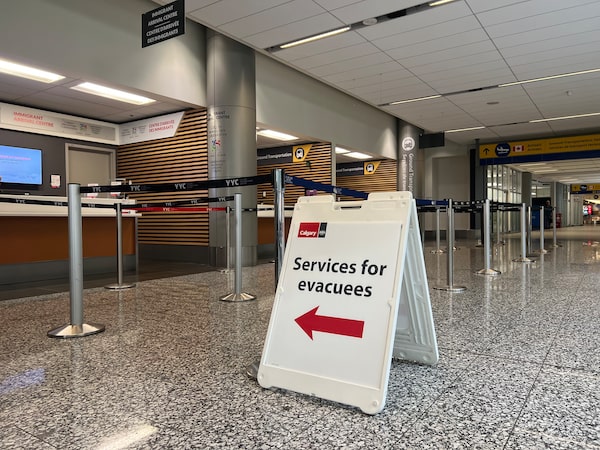
Large white floor signs have been positioned in the arrivals level of Calgary airport, directing evacuees.Handout
Calgary airport workers are bracing for an influx of evacuees scheduled to begin arriving later Thursday from the Northwest Territories, where thousands have been ordered to leave as wildfires threaten communities.
Large white floor signs with bright red arrows have been positioned in the arrivals level directing evacuees to a makeshift support station, located at the Immigrant Arrival Centre. Airport staff were preparing spaces mid-afternoon on Thursday for the orderly lineup of evacuees.
In a nearby room, written on a dry erase board, is information on smoking and pet relief areas and directions to get to the nearest washroom. Another paper attached to the board, with a City of Calgary logo, lists translation services available for non-English speakers.
4:02 p.m. ET Aug. 17
Winds and humidity could worsen blaze, says NWT fire service
The Northwest Territories fire service says there are “very tough days ahead,” with strong winds expected Friday and Saturday that will blow wildfires closer to Yellowknife.
In an update posted online, the service said winds are expected to shift north, with gusts of up to 40 kilometres per hour by the afternoon. Relative humidity could also heighten fire activity.
“There is a possibility that this fire reaches the outskirts of Yellowknife by the weekend. However, some isolated showers seen overnight. Whether additional showers occur will make a significant difference,” the update said.
Fires moved slightly closer to Yellowknife overnight and pushed closer to Highway 3, which leads out of the city to Alberta. The service said that doesn’t mean the highway is unsafe for travel, and officials are directing drivers through the fire zones to ensure the safety of evacuees.
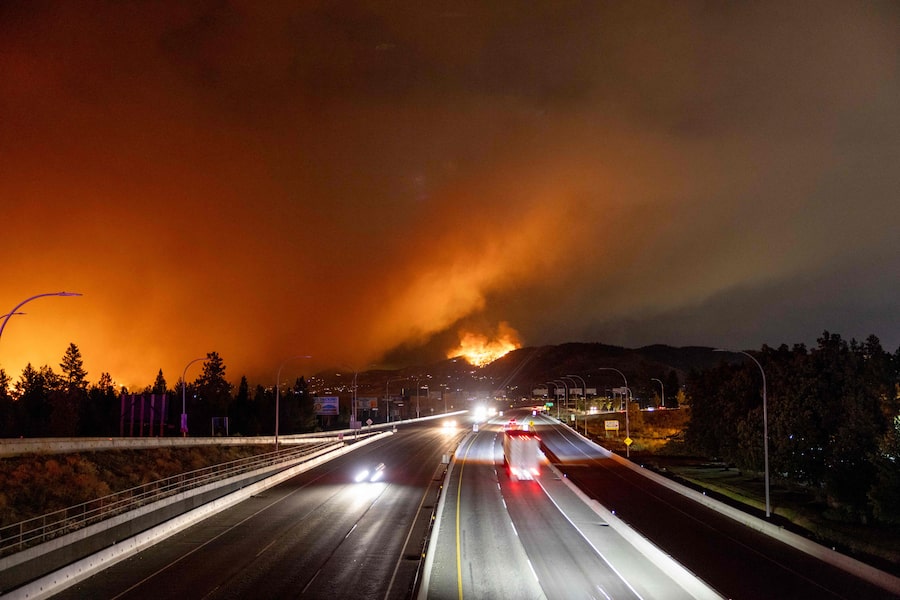
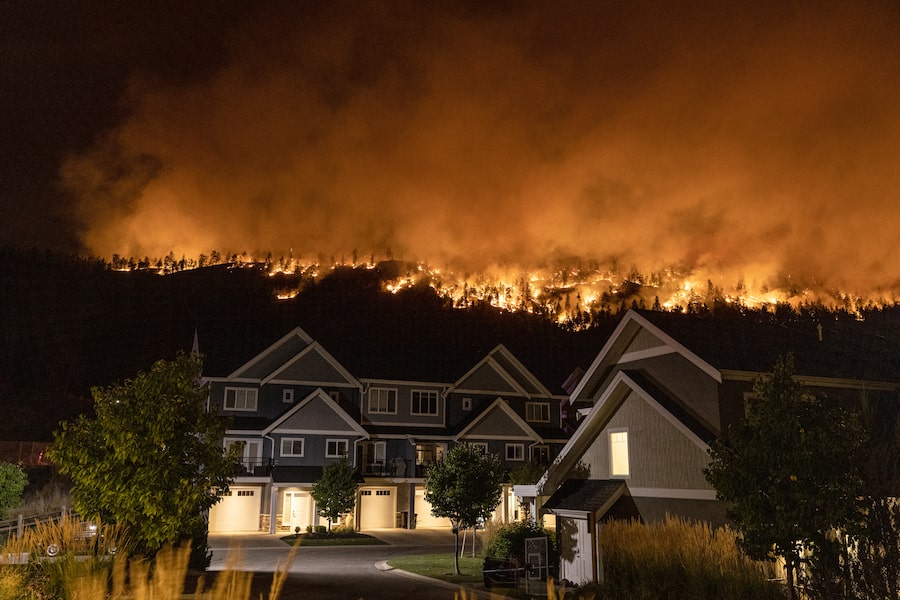
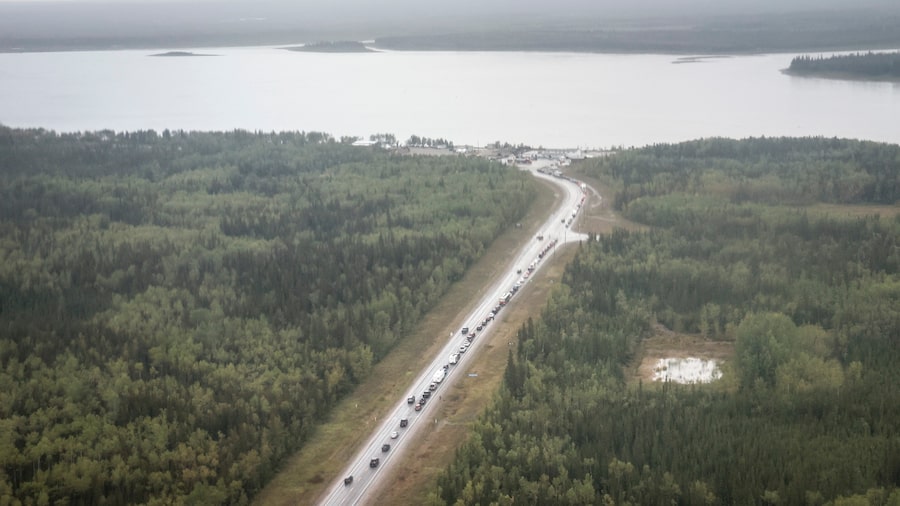
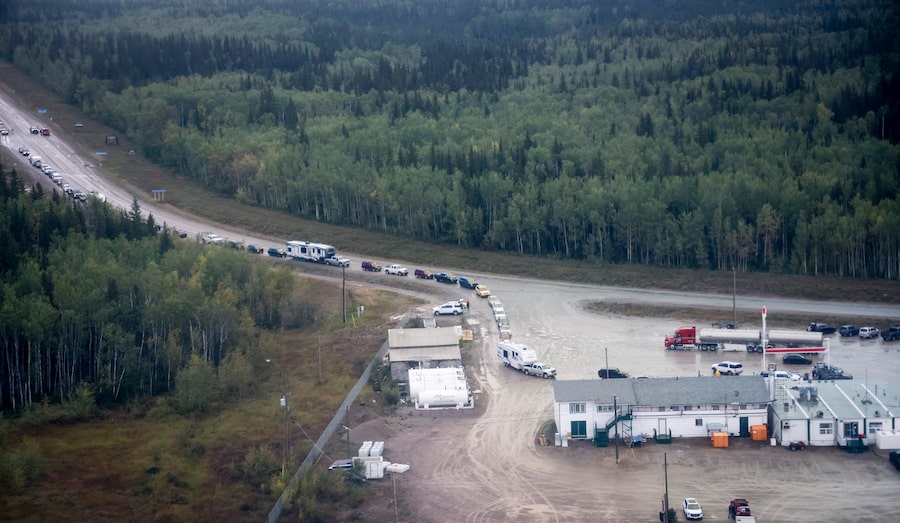
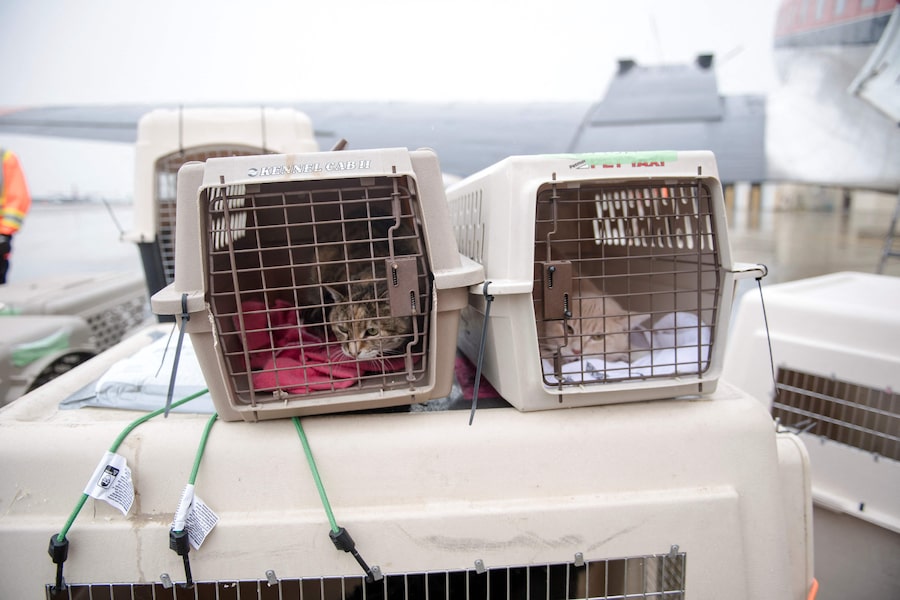
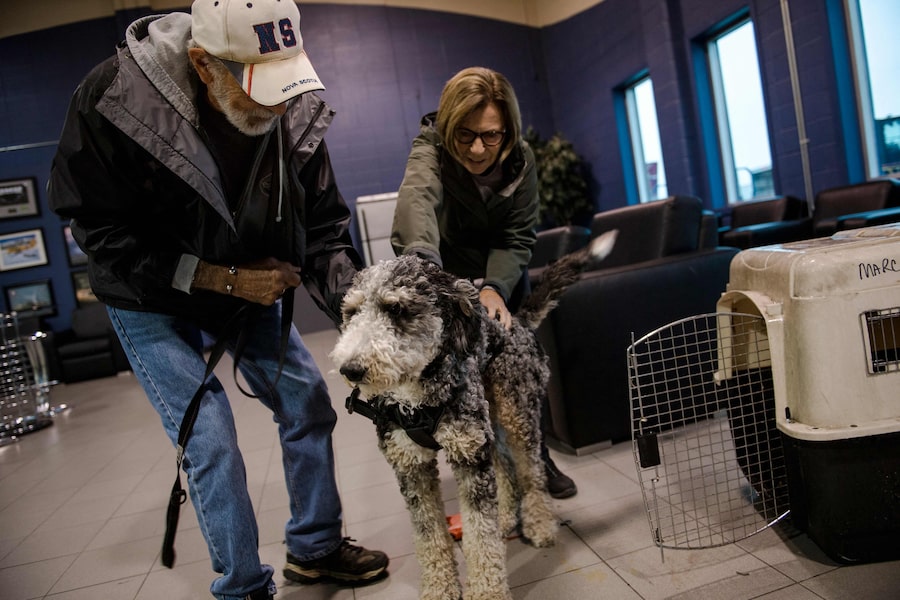
 Carrie Tait
Carrie Tait Alanna Smith
Alanna Smith Wendy Cox
Wendy Cox Kristy Kirkup
Kristy Kirkup Mike Hager
Mike Hager Dustin Cook
Dustin Cook